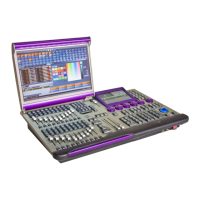
Do you have a question about the Compulite Vector Violet and is the answer not in the manual?
| Brand | Compulite |
|---|---|
| Model | Vector Violet |
| Category | DJ Equipment |
| Language | English |
Steps to power on and connect the console to the mains supply and peripherals.
Guide to setting up an external DVI monitor as the primary display.
Explains tracking vs. Compulite modes and their associated programming syntaxes.
Overview of the console's default screen interface and its customizable elements.
Details of various UI components like window title bar, menu bar, and command line.
How to use the trackball and vertical wheel for navigation and selection.
Procedures for creating and managing windows and view panes on the console.
Customizing function keys (tabs) for quick access to libraries, QLists, and more.
Managing multiple virtual desktop areas for different operational tasks.
Methods to save and restore custom screen configurations and workspace setups.
Process for creating a fresh show environment, clearing existing data.
Introduction to fixture patching, DMX addressing, and configuration.
Steps to add fixture profiles from device files into the system.
Detailed guide on creating fixtures and assigning them to DMX addresses.
Procedures for removing fixtures and their associated DMX patch data.
Finalizing and saving patch changes before exiting the manager.
Using direct console commands for efficient fixture patching.
Overview of methods for selecting fixtures and adjusting parameter values.
Understanding the real-time output grid showing fixture status.
Methods for choosing fixtures using console keys and the editor toolbar.
Techniques for precise fixture selection using filter options.
Creating selection shortcuts for groups of fixtures.
Manually creating and naming custom fixture groups.
Using wheels and encoders to adjust fixture attributes like intensity and position.
Inputting parameter values numerically for precise control.
Organizing cues into sequential lists for playback.
Procedures for saving lighting states as cues within QLists.
Methods for removing individual cues or ranges from QLists.
Setting transition durations (fade in/out, delay) for cues.
Programming and updating cues without affecting live output.
Editing the next cue in the sequence while in blind mode.
Overview of faders, QKeys, and AB crossfader playback controls.
Description and function keys of fader playback devices.
Explains different operational modes for faders (PB, Rate, Channel).
Description and functionality of QKey playback devices.
Assigning and unassigning QLists or temporary cues to playback controls.
Designating and operating the primary playback device for show control.
Procedures for freeing playback controls without removing assigned QLists.
Accessing visual feedback for playback devices via the Workspace tree.
Capturing and restoring playback device states and configurations.
Using cues for temporary playback control and as building blocks.
Creating sequences of cues that play automatically.
Setting up repeating cue sequences within QLists.
Applying spread values to parameters across fixtures for effects.
Configuring fan direction, values, and types for effects.
Adjusting the timing parameters for fan effects.
Introduction to dynamic parameter sequences for creating visual effects.
Interface for creating, editing, and managing effects.
Using and customizing pre-included effect libraries.
Procedures for storing effects as cues or libraries.
Methods for removing applied effects from fixtures or cues.
Procedures for saving the current show configuration and data.
Loading previously saved show data and configurations.
Transferring specific data like patch or libraries from other shows.
Specific troubleshooting tips for Vector Violet consoles.
Solutions for black screen issues on connected displays.
Specific troubleshooting tips for Ultra Violet consoles.
Troubleshooting steps when the main screen appears on the 7" monitor.
Solutions for black screen issues specifically on the 7" monitor.